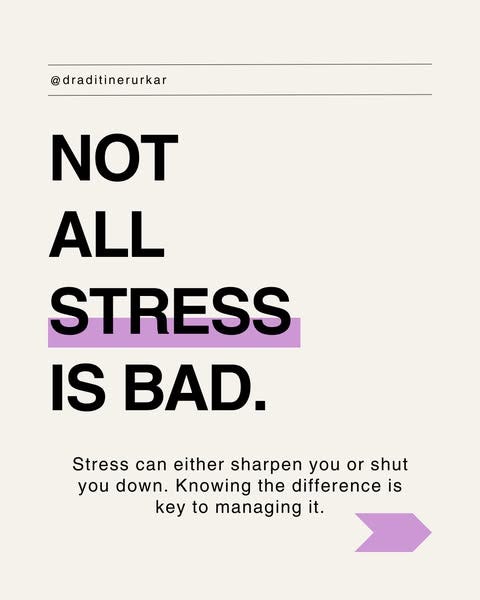There’s a secret the multibillion dollar wellness industry doesn’t want you to know: life without stress is biologically impossible. Forget the false advertising that your stress can magically disappear with the right product. Your brain and body biologically rely on stress to function optimally, but it has to be the right kind of stress.
In science, there are two kinds of stress, and they affect your brain and body differently. One serves you, the other can harm you. Knowing the difference is the key to moving out of survival mode back to thriving.
Good stress motivates you. This kind of stress helps you feel productive and engaged with your everyday life. Healthy stress creates a sense of forward momentum. Think of a new job or promotion, starting a new relationship, having a baby, or even planning a vacation or rooting for your favorite sports team. These high-intensity moments help drive your life forward. Healthy stress is called adaptive stress because it helps you adapt to life’s changing circumstances. Chances are, everything good in your life was created because of a little bit of healthy stress.
Bad stress overwhelms you. This type of stress is unhealthy, dysfunctional and unproductive. It’s what you mean when you say, “I’m so stressed.” Unhealthy stress leads to many of the mental and physical health manifestations you’re already familiar with like anxiety, insomnia, depression, fatigue, irritability, brain fog, or physical symptoms like muscle tension, chronic pain or frequent headaches. Bad stress is called maladaptive stress because it gets in the way of your everyday functioning. This is the type of runaway stress you want to transform back to healthy, manageable levels.
The goal of life isn’t zero stress. That’s biologically impossible. The goal of life is healthy, manageable stress that serves you rather than harms you.
You can rewire your brain away from unhealthy stress back to healthy levels through a process called neuroplasticity. Which is just a long, fancy word to say that your brain is a muscle, just like your biceps. In the same way you can train your biceps to become stronger, you can also train your brain for less stress and more resilience. Before the discovery of neuroplasticity, the scientific community used to think that the brain you had at birth was the same brain you’d be stuck with for life. Yup, a real grab bag. We now know that your brain can change according to your behaviors, and neuroplasticity is what gives you the ability to rewire your brain. Neuroplasticity isn’t just for young brains, either. You can rewire your brain for less stress at any age. Just ask my 95-year-old patient who transformed her unhealthy stress back to healthy levels using her brain’s ability to rewire itself. If she can do it, so can you. It just takes a little time, patience and practice.
This week’s mental health reset: Reflect on an experience that sparked good stress for you. How did it create forward momentum in your life? In what ways did your brain rewire itself to adapt to this new circumstance? Once you understand how good stress shows up in your life, it’s easier to differentiate this from bad stress. Because not all stress is created equal.
Next week, I’ll teach you a brain rewiring technique to get better sleep called revenge bedtime procrastination and explain why you’re still doomscrolling late at night even though you don’t want to. Spoiler: It’s not you, it’s your biology of stress working exactly as it should!
Until next week,
Join me LIVE: Your burning mental health questions, answered by me! Join me live every Thursday in May at 12pm EST on Substack for a Q & A. Send me your questions in the comments or reply to this email and I’ll answer them live. If you have a friend or family member struggling with stress or mental health, share this newsletter as a resource. Let’s support one another through this difficult time.






such a good read!